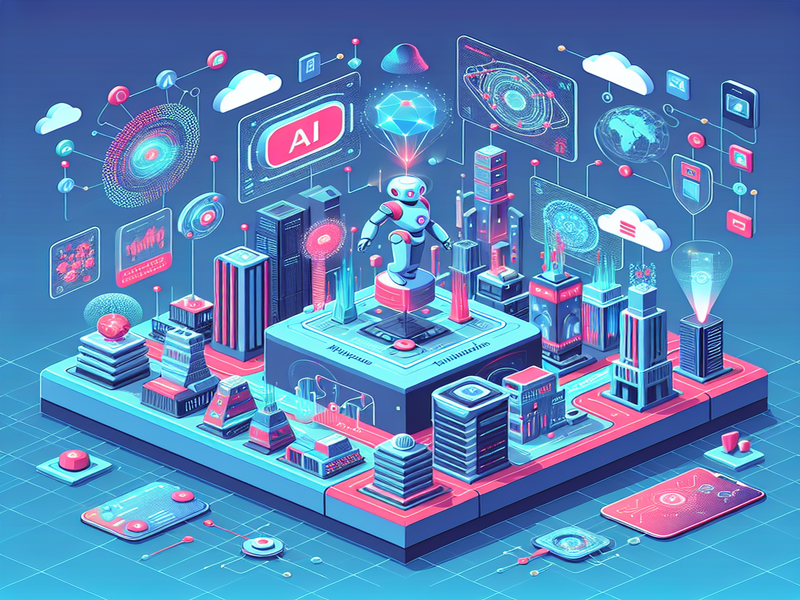- Updated: July 29, 2024
- 4 min read
NVIDIA Brings Physical AI Through NIM Microservices for Digital Environments
Unleashing the Power of Physical AI: NVIDIA’s Groundbreaking NIM Microservices and Generative AI Integration
In a groundbreaking move, NVIDIA has unveiled a suite of cutting-edge technologies that promise to revolutionize the way we interact with and experience digital environments. At the forefront of this innovation are the NVIDIA NIM (Neural Inference Microservices) and the integration of generative AI into 3D worlds and USD (Universal Scene Description) workflows.
Introducing NIM Microservices: Bridging the Gap Between AI and Physical Reality
NVIDIA’s NIM microservices are a game-changer in the realm of generative AI, enabling developers to seamlessly integrate AI capabilities into a wide range of applications. These microservices are designed to support NVIDIA’s deep learning framework for 3D worlds, allowing for the creation of immersive and intelligent digital environments.
Among the newly announced offerings are three fVDB NIM microservices, which enable developers to work with cutting-edge technologies like the Chroma DB integration and USD Code, USD Search, and USD Validate microservices. These tools empower developers to infuse their 3D worlds and USD workflows with the power of generative AI, opening up a world of possibilities for interactive and intelligent digital experiences.

Unleashing Physical AI: Revolutionizing Industries with Visual AI Agents
NVIDIA’s vision of “Physical AI” is rapidly becoming a reality, with the introduction of visual AI agents powered by vision language models (VLMs). These cutting-edge agents are already being deployed in a wide range of industries, from healthcare and manufacturing to smart cities and transportation.
In the historic city of Palermo, Italy, for instance, NVIDIA NIM-powered agents are helping to manage traffic more efficiently by uncovering physical insights that enable better roadway management. Similarly, industry giants like Foxconn and Pegatron are leveraging these technologies to design and operate virtual factories, enhancing safety and operational efficiency.
“Physical AI, which uses advanced simulations and learning methods, is transforming sectors like manufacturing and healthcare by enhancing the ability of robots and infrastructure to perceive, reason, and navigate.” – Jensen Huang, NVIDIA CEO
Bridging the Simulation-to-Reality Gap with Synthetic Data
One of the key advantages of NVIDIA’s physical AI software, including VLM NIM microservices, is the ability to facilitate a “simulation-first” approach. This approach is crucial for industrial automation projects, as it enables the creation of digital twins that simulate real-world conditions, allowing for more accurate and effective AI model training.
By leveraging synthetic data generated from these simulations, companies can replace costly and hard-to-obtain real-world datasets, leading to improved model accuracy and performance. NVIDIA’s NIM microservices and Omniverse Replicator are key components in building these synthetic data pipelines, enabling organizations to bridge the gap between simulation and reality.
Revolutionizing Industries with Generative AI and USD Workflows
The integration of generative AI into 3D worlds and USD workflows opens up a world of possibilities across various industries. From enterprise AI platforms to robotics and digital twins, the ability to infuse intelligent agents and copilots into these environments promises to transform the way we design, develop, and interact with digital experiences.
- In the manufacturing sector, generative AI agents can assist in optimizing production processes, identifying inefficiencies, and suggesting improvements based on real-time data analysis.
- In the entertainment industry, these technologies can revolutionize the way we create and experience immersive virtual worlds, enabling more realistic and dynamic environments that adapt to user interactions.
- In healthcare, generative AI agents can aid in medical imaging analysis, patient monitoring, and even surgical planning, leveraging vast amounts of data to provide valuable insights and recommendations.
Conclusion: Embracing the Future of Physical AI and Generative Intelligence
NVIDIA’s groundbreaking advancements in Physical AI, including the introduction of NIM microservices and the integration of generative AI into 3D worlds and USD workflows, mark a significant milestone in the evolution of intelligent digital environments. By bridging the gap between AI and physical reality, these technologies have the potential to revolutionize industries, drive innovation, and unlock new realms of possibilities.
As we move towards an increasingly digital and interconnected world, embracing the power of Physical AI and generative intelligence will be crucial for organizations seeking to stay ahead of the curve. With NVIDIA leading the charge, the future of intelligent and immersive digital experiences has never been brighter.
To learn more about how UBOS can help you leverage the power of generative AI and AI solutions for SMBs, visit our website or explore our templates marketplace for a wide range of AI-powered applications and solutions.
